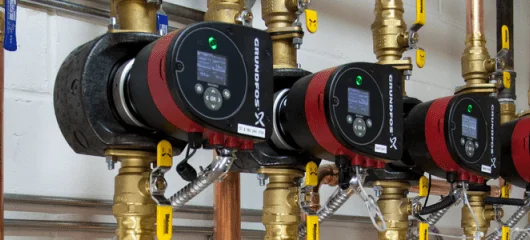Hydronic distribution manifolds are most often mounted in a lower level of a residence, typically near the boiler or other heat source. When the heat emitter circuits are located on that same level or happen to be lower level in-floor radiant loops, the manifold is typically wall mounted with the tubing connections going downward. For installations where the heat emitters are above the manifold, for example with staple-up radiant floor loops or radiant panels located throughout the upper levels of a residence, it makes a lot of sense to have the manifold "inverted", meaning the tubing connections go upward from the manifold.
A Caleffi manifold can be field-modified to be inverted and in doing so, the air vent assemblies must be turned around so air can vent out the tops. The flow meters on Caleffi's 668S1A are spring-opposed so it's no problem to have those mounted upside down. Also, for individual loop control, the Caleffi 6564 Series low current draw thermo-electric actuator is hermetically sealed so it can be mounted upside down.
For those installations where the heat emitters are above the manifold, save big time and installation costs by ordering the Caleffi manifold "inverted". We don't charge extra to do this, just specify "inverted" on the order and we'll build it ready to install with the tubing connections upward. Check out Bob "Hot Rod" Rohr's short video on the topic!
Call me if you have any questions about this! Thanks for reading...Kevin







Nice feature. Not all manifolds can be successfully inverted.
Yes, it is a nice feature that not everyone knows about, so we want to get the message out there. The flow meters work just fine upside down and our 6564 Series zone actuators are hermetically sealed so they are perfectly happy being mounted upside down on the manifold too.
Hi. Where does the tubing from the bottom right-most port on return manifold get routed to? Wouldn't the tubing run into the bracket on the hot water supply manifold above (because the bracket is offset)? What is the work around for that? Thanks
In reply to Hi. Where does the tubing by Roy Zimmerman
Good question, Roy. The mounting brackets clamp to the hex part of the manifold casting, and they are offset enough to allow the tubing to run by the "indent" area. It's a little hard to see in that image, perhaps.
In reply to Good question, Roy. The by Kevin Freidt
I'm sorry, I should have been more specific. In the video, when the manifold is inverted, the bottom right most port (now facing upwards) is offset towards the upper bracket (instead of being offset towards the indents in the manifold casting). I suppose you could rotate the manifold (towards yourself) in the bracket (or tweak it a bit) so that the tubing clears the upper bracket, but is no longer directed perfectly vertical. I guess you could also flip the manifolds around in the bracket, so that main 1" inlet and outlets are coming out the other side, but that changes the piping header plan.
In reply to I'm sorry, I should have been by Roy Zimmerman
Roy, in an inverted assembly the tubing from the bottom manifold will come over the top of the upper manifold. In this case, yes, the tubing connected to the bottom manifold on the far right port will end up coming over the top of the clamp between the far right port of the upper manifold and the air vent. The clamp doesn’t stick out very far and shouldn’t cause a problem.
In reply to Roy, in an inverted assembly by mary_olson
to keep the indent on the far right in line with the supply, could the supply manifold be built reversed, ( not flipped end over end) the air fittings to go on the other end. The manifold has more space before the threaded end on one side. this adds a bit of offset and seems to align all of the ports. The issue may be the bracket holding the supply at the correct place in relation to the mixing station output. Any problems with this??
Is there any concern when you field modify the manifold to be inverted, that the air vent assembly can no longer be snugged up tight to the body of the manifold (like when it was shipped as the non-inverted assembly)? Another way of stating this is: since the air vent assembly has to be rotated to stay in the up-right position it must be loosened from the body of the manifold--leaving a ~0.047" gap between the two. Please advise.
In reply to Is there any concern when you by Roy Zimmerman
There is a little rotational room where the air vent/fill valve end-cap connects to the manifold body but it may leak if too far unscrewed. If it does leak, you'll need to leave the end cap tight and swap the air vent and fill valve. Sealant is used to connect the vent and fill valve to the end cap, so it will take some muscle (and maybe some carefully applied flame) to unscrew them.
In reply to There is a little rotational by Kevin Freidt
Please tell me what type of sealant Caleffi uses on the vent and fill valve. I have 5 manifolds that have been converted to run inverted. I have removed the vents and fill valves (with careful heat) and would like to use the same sealant to put the fittings back in. Thanks! (If unable to post publicly, please private email me.)
In reply to Please tell me what type of by Roy Zimmerman
Roy, that’s a great question. In our assembly process we use Loctite 545 and Loctite 272. I’ve attached a picture to show where each is used on the fittings.
Are these still available or has this program ended?
Thanks,
Sure, the inverted manifold option is permanent. Just tell us "inverted" in your order.
Could you please provide a procedure document (or make a video) detailing the exact steps and materials required to invert a 6686HS51A manifold? Tracking the two types of Loctite, but I don't want to miss any critical step.
I wish my distributor had reminded me of this option (I told their sales engineer this particular job was for a staple-up application). Perhaps more messaging to the distributors and the field about this option would be helpful.
Loctite 272 and 545 are quite hard to come by. Can you recommend an acceptable alternative that is more widely available?
Due to the popularity of inverted manifolds, and to make it easier for customers to order them for staple-up applications, we are adding specific "...IN" model numbers to our 2018 Catalog. We do not have a recommendation for a more widely available sealant, sorry.
I have a basement and two floors, front yard and back yard. I have patio and deck on back yard and porch in front yard. I am gong to install manifold, water heater in utility room. The utility room is towards rear of basement near back yard. I want to install hydro radiant in front driveway. Now the front of the house from utility room is about 70 feet. My question is do we have to run pex from the manifold or I can bring the valve near the front. I mean bring the copper close to front and then run pex from their for shorter run of pex. So 1 zone manifold in front
Shawn,
Thank you for your interest!
You can certainly remote mount the manifold to get it closer to the load. In many snow melt applications, the manifolds are mounted in a "yard box" outside.
Good luck with your project.
Cody Mack
Caleffi North America
When mounting the manifold below the level of pex (manifold on first floor. Heated pex 2nd floor. Dose this create issues for possible air traps ? Making air blockiage ?
I seen a installer Video saying manifold must allways be mounted higher then the pex route
Please explain Thank you
Eduard,
Regardless of the orientation of the manifold, you will have potential for air in the system that will prevent flow. The key is proper flushing and purging of the lines when the system is installed. A good central air separator like our Discal will also help!
Cody Mack
Caleffi North America
When mounted inverted the location of the flow meter pointing down has allowed debris to settle within the sight glass. Can the the flow meters be removed to be cleaned? If a flow meter is removed, is a thread sealant (Loctite 545, Loctite 272 as mentioned above, or other) needed during reassembly?
In reply to When mounted inverted the by Jay
Jay, The flow meters can easily be removed. The are threaded into the manifold and seal with an o-ring. They are also offered as a replacement part for the manifold Caleffi part number F69600. Dirty flow meters are a sign of debris in the system. You may want to look at a system flush or dirt or magnetic separation as a way to clean up the system.
Is it possible to reverse the manifold direction end-for-end? I have an application where it would be more pipe-efficient to run the supply/return connections to the right side of the manifold. Thanks!
In reply to Is it possible to reverse the by Dan Wilcox
Dan, If the supply and return connections to the manifold are entering the right side you could remove the manifold from the bracket and flip it over and reconnect the bracket. This would position your main connections to the right side. You will be able to reposition the flow meters and shut offs to still be able to read and access what is needed for isolation.
I have built a wet riser in my house but plumber is telling me it is not wide enough to accomodate the number of zones I need on my manifold. Is there any reason I can't mount the rails vertically and just have the pex running through a slow 90 degree bend back to the floor?
In reply to I have built a wet riser in by Gareth Cranston
Gareth, You can mount the manifold in any configuration, horizontal or vertical to fit your install. There is no restriction to performance based on how it is mounted.
My system will have the manifold in the basement, with some loops located on that level and some above on the first floor. Is it possible (and advisable) to have some ports inverted, and leave others in the standard orientation on the same manifold?
In reply to My system will have the by Gary Fisher
Gary, You can order our manifolds as standard or inverted. You cannot order them combined. It may be easier to order separate manifolds in this application. One standard and one inverted and just run separate supply and returns to the individual manifolds.
The cut sheet states that the thermo-electric actuator can be mounted to a zone valve. Have I mistakenly assumed the actuator took the place of a traditional zone valve? Why would I need one over the other, or do I need both?
Charles, our thermo-electric actuators work with our 6767 and our 6762 series zone valves, as well as our manifolds. They will not work with our Z2 or Z3 valves. Those would require a Z1 actuator.